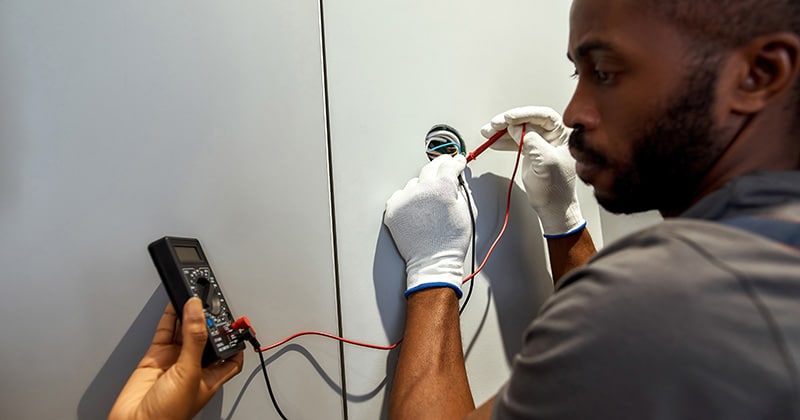If you’re a small business or a new contractor, bidding on jobs can seem overwhelming. This article removes all the mystery and gives you a step-by-step guide on how to bid on electrical jobs.
There are multiple factors to consider when preparing a bid. But when you approach the process methodically, it’s easy every time. That frees you up to concentrate on billable work that boosts your bottom line.
You can use the 10 steps below as a checklist when submitting electrical contracting bids. Plus, you get expert advice on how to avoid common mistakes when preparing bids. Stay ahead of your competition and win more jobs with this mini 101 course on electrical bidding.
The Importance of Bidding on Electrical Jobs

Bidding is an essential part of owning an electrical contracting business. It’s nice to get direct referrals from previous clients or via friends and family. But the reality is you will likely have to compete for some of the best jobs out there.
Submitting a bid may put your business in competition with one or two other contractors. Or you might throw your hat in the ring with a dozen or more other firms. The key is to make your bid appealing enough to the client so they choose your company over the others.
Your bid for an electrical job should also present your contracting business as a professional one. Ideally, if this job goes well, you’ll be invited to bid on future projects with the same client. Or if they’re really impressed, you could eventually get awarded other jobs without having to compete at all.
The bid you assemble for an electrical job isn’t just to get you in the door. It’s your roadmap for completing the project. Construct your bid right, and everything will fall into place well as you work on the job. You’ll already have factors like the budget, staffing, and supplies figured out.
Your bid is also a pledge to the client. If you finish the project as promised—or even overdeliver—your reputation will grow. That’s great for both keeping your business in a stable financial position and for scaling when the time is right.
FROM ONE OF OUR PARTNERS — How to Start a Small Electrical Contractor Business
Mastering Electrical Job Bidding: 10 Steps to Success

You can become a master at bidding electrical jobs when you break the process down into steps. Here are 10 steps to follow to set your business up for success:
1. Decide What Types of Jobs You Should Be Bidding On
The first step in winning bids for electrical projects is to bid on the right jobs. What is the right job for your business? It should meet these criteria:
- Your company has the right experience and qualifications.
- You have the required labor force and equipment.
- It pays sufficiently for your projected revenue stream.
- You can complete the job in the requested timeline.
- The project is located within your geographic service area.
- You have a strong chance of beating the competition.
Ideally, you’ve already created a customer profile or avatar. This is a hypothetical client that you typically serve or have the credentials to pursue as a prospect.
For instance, you may specialize in electrical work for historic renovations. Or you serve a commercial client niche like restaurants, small office buildings, or mom-and-pop stores.
You should have a pretty good idea of the size and scope of projects that your business can actually do. And it’s even better if you have references or testimonials from clients to back you up.
It’s not worth it to pursue electrical contracting jobs that are way outside the range of your experience. You need to build up to those jobs little by little, starting with projects that match your skill set and customer base.
Finding Projects to Bid On
How do you find these jobs to bid on, outside of referrals from people you already know? There are multiple ways to identify potential electrical contracting projects:
- Subscribe to municipal or federal publications advertising jobs and requests for proposals (RFPs).
- Join membership organizations like your Chamber of Commerce to meet business owners.
- Connect with architects, general contractors, and other construction professionals who know about jobs.
- Advertise in local newspapers or on your community’s group Facebook page.
- Make an effort to meet developers, real estate agents, landlords, and property managers who need electricians.
2. Review the Specs and the Client’s Needs
Once you know about an available job, it’s time to go over the job specifications thoroughly. You want to know as much as possible about the job particulars and any potential challenges. You also need to make sure the budget for the project is worth it and that you can complete the job in the allotted time.
Any materials you can get your hands on will help. This includes blueprints, photographs, and other documents. Even better, a visit to the jobsite can reveal more about the job and what to expect.
Be sure you’re clear on any insurance or bonding requirements for a job. You should carry at least normal business liability and workers’ compensation insurance. But you may also need a bond that promises to complete the work on time to a certain professional standard.
There are less tangible client needs to consider too.
They may need a contractor who’s sensitive to working within the confines of a pre-war apartment building. You might have to get creative with wiring solutions to accommodate thick cement floors or few options for placing outlets. Be sure to tout your unique skills if you can solve a problem for the client!
Some clients need a contractor who can hold their hand, so to speak, through a remodeling job. Others want an electrical professional who can work independently. They only want to be contacted when they need a decision made. The more you can find out about this customer’s management style, the better.
3. Perform a Quantity Takeoff to Calculate Materials Required
Electrical estimating requires that you tally the cost of materials for the job, known as a quantity takeoff. This includes items like:
- Wiring
- Junction boxes
- Switches
- Outlets
- Breakers
- Tape
- Hardware
- Caulk
- Fixtures
Basically, if you’re buying it for the job, it goes in the budget. Each type of item should get its own line, with the cost per item next to it.
Then multiply each line item by the quantity to get the total cost per item. At the end, you can total the entire cost of materials as a final sum.
Do you need to rent any equipment for this project? You can add that to your materials cost, too.
RELATED ARTICLE — How to Price Residential Electrical Work
4. Obtain Materials Quotes from Your Suppliers
In order to get an accurate quantity takeoff, as described above, you need to get quotes from suppliers for materials. You want to get the most current price for materials, as well as inquire about any possible discounts for bulk purchases.
Be sure to ask about whether or not the items you need are in stock. If any specialty items need to be shipped, include the shipping price in your budget. Also, make certain they will arrive by the time you need them on the jobsite.
5. Calculate Labor Needs and Costs

Next, you need to figure out how many people you require for the job and what that labor will cost. There are several ways you can calculate labor.
Hourly Rate
Some contractors like to use an hourly rate. Simply multiply the fully burdened wage of each person on the project by the number of hours they’re expected to work.
What is the fully burdened rate for employees? Also known as the fully loaded rate, that’s their wages plus any taxes and benefits you pay, such as insurance or paid vacation time. It can also include your overhead and profit margin, as reviewed below.
Not sure how much time to allot? You can either use past projects or the NECA (National Electrical Contractors Association) Manual of Labor Units.
Charging by the Drop
Another way to calculate labor is by the drop. This works best on smaller jobs or simple installations, where you charge a flat fee for every electrical outlet or connection point you set up.
Flat Rate
You can also charge a flat rate for the job, which typically includes both time and materials. There are pros and cons to this.
One advantage is that there are no surprises for either party, provided the scope of the project doesn’t creep up.
Also, a flat fee is easier for residential clients to understand. They may not fully comprehend that your total fee includes fully loaded labor plus overhead and your profit (see below). Most commercial clients get this.
The downside is that you need to be sure the parameters of the job won’t change. You’ll have to have a clause in your contract to deal with that. It should outline what happens if the job requires more time due to, say, an unexpected problem encountered midway.
6. Add in Overhead Expenses
You should know your overhead expenses when preparing each bid. If you calculate them only periodically when there is a change, you don’t have to do it very often. You can just plug this number into your estimate.
Most contractors don’t include overhead or profit (below) as line items. Rather, they incorporate them into their hourly or flat fee rates.
What’s overhead? It’s all the costs you take on behind the scenes to keep your business running, such as:
- Office rental
- Utilities
- Insurance
- Vehicles and fuel
- Marketing
- Taxes
- Licenses and permits
- Bookkeepers
- Computers and software
You need to include this in your bids in order to at least break even when operating a business.
RELATED ARTICLE — How Electricians Can Reduce Administrative Overhead with Online Payments
7. Decide on Your Profit Margin
Total up all of the budget items above. That’s your cost to break even on a job. But, of course, you want to make a profit on every project, so you need to factor your profit margin in too.
Most electrical contractors calculate their profit as a percentage of the job. A typical profit is anywhere from about 10–20%.
How do you decide how much extra to charge?
In some cases, there may be a budget cap on the client’s end that limits your profit margin. In other instances, you can use the size of the job as a guide.
A huge project that costs upward of $20,000 will yield a tidy profit even if your percentage is smaller. However, little jobs may need a larger profit to be worth it in the end.
Working a bunch of small jobs can cause your overhead to climb quickly. Think about things like the cost of traveling between sites throughout the day or the time needed to schedule staff. It can be easy to miscalculate your overhead in this scenario, unlike one where everyone works at the same site for two weeks or longer.
You also want to look at factors like:
- The current market for your location
- The “headache element” of a difficult job
- The potential for the job scope to increase
- The value of the job for your portfolio
- The desire to get more jobs from that client
Sometimes it’s worth it to take less profit if the customer will give you a large volume of steady work in the future. Or perhaps they will let you photograph the project in detail for your website or YouTube channel.
On the other hand, you might have heard that this client makes collecting on invoices difficult. Maybe they pay on a 90-day term versus on receipt or net 30. Some clients have a policy of not paying a deposit up front (which is always worth trying for). In that case, you could bump up your profit to absorb the hassle.
8. Build Your Estimate Using Software for Contractors
If you use electrical estimating software or estimate templates, completing your bid will be much easier. It will walk you through all the factors listed above, and you can plug in the numbers. Change a line item, and the total for the estimate will shift accordingly.
It’s also easy to try out different pricing models using contractor software. You can choose between hourly or flat rate pricing, for example, to see how each would look from the client’s perspective.
9. Review Your Bid and Make Any Necessary Adjustments
Before sending your bid, give it a thorough review. In fact, have a couple of people put eyes on it if possible.
Look for typos or errors that could make your business look unprofessional…or worse, mistakes that could cost you money. Make sure there haven’t been any changes to materials costs since you started creating the bid. Prices have been volatile lately, and you don’t want to lose money by underestimating the expense of supplies.
10. Submit Your Proposal with an Invitation for Any Questions
Your bid is finally ready! Go ahead and send it to the client in the format they requested, whether online or in print.
It’s smart to let the customer know you’re open to any questions they might have. Perhaps they want a lower-cost option for part of the project, or they want to know what the luxury version would run.
You might get a customer who responds to a bid by saying, “That’s too expensive.” Do you need the job or really want to work with this customer for the experience or prestige?
A good reply is, “What did you find too expensive? Maybe there are some components of the job we can pare down.”
Another option is, “Tell me your budget, and I’ll let you know what we can do for that. Maybe we can find a happy middle ground.”
FROM ONE OF OUR PARTNERS — The Top 11 Magazines for Electricians
6 Tips to Avoid Bidding Mistakes

It’s not uncommon for small electrical contracting businesses to make mistakes when bidding on jobs. This is especially true in the first year or two of operation. But you can avoid these errors by following these six expert tips:
- Know your customer profile, and only bid on those jobs. For instance, say you’ve only done residential electrical wiring. Bidding on large commercial projects is outside your scope of experience. It’s better to invest your time in jobs you’re more likely to win and succeed at.
- Don’t try to outbid the competition by lowering your fee to an unreasonable level. Instead, sell your services based on experience, reliability, and the quality of your work. You need to make a profit on every job, and clients should see that they get what they pay for.
- Be realistic about the amount of time and labor involved in any job. Otherwise, you could find yourself exceeding the deadline for completion. The way to win favorable reviews and repeat business is to meet the timetable you give the client every time.
- Supply chain delays, tariffs, and other unpredictable factors are normal today. It’s smart to build in buffers for both prices and time when submitting a bid. That way, you won’t hurt your bottom line if you hit slow shipping or increased material costs.
- If you find your company is losing a lot of bids to competitors, investigate why this is happening. Be ready to change your bidding strategy or even your business model if necessary. For example, if your estimated timetable is too long to complete jobs, consider hiring another contractor or two to speed up the work.
- Use a job bid template or contractor software like Joist to create your estimates. This will reduce errors and help ensure you don’t leave anything out. And it saves time with future bids for similar jobs or repeat customers.


